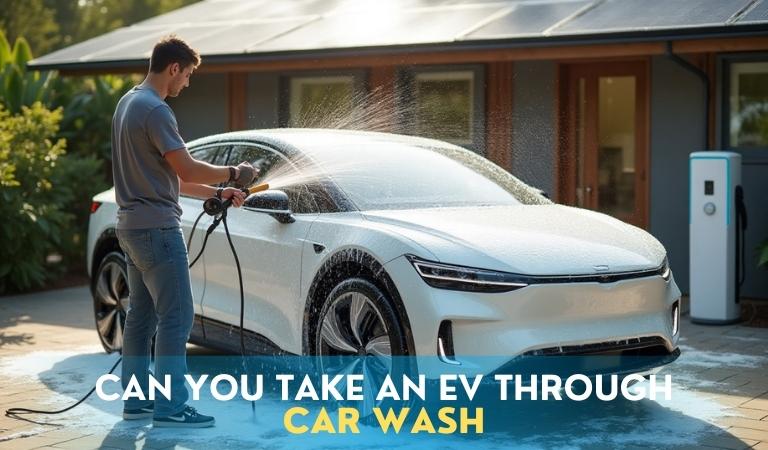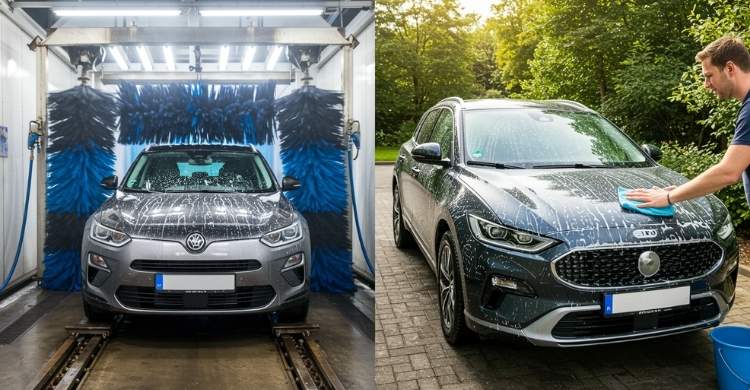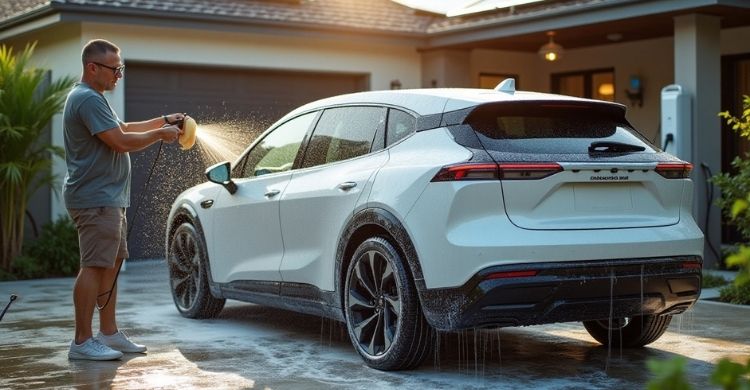Electric vehicles have gained popularity in recent years for their efficiency, eco-friendliness, and innovative technology. As more drivers make the switch, new questions arise about day-to-day maintenance, including a common concern: Can you take an EV through a car wash?
Yes, you can take your EV through automatic car washes, tunnel washes, or self-serve jet washes. The advanced design of EVs means their batteries and electronics are well-protected against water. However, it’s wise to follow your manufacturer’s guidelines and keep an eye out for any exposed parts or aftermarket modifications.
Want to learn how to safely clean your EV and avoid common pitfalls? Read on for expert tips and advice.
Can You Take an EV Through a Car Wash?
If you own an electric vehicle, you might wonder if it’s safe to use a car wash. The simple answer is yes, you can take an EV through a car wash. But there are some things you should keep in mind before you do. Knowing these details will help keep your car safe and clean. Below you will find instructions on how to properly wash your electric vehicle:

Choose the Right Car Wash
Pick a car wash that suits your needs—automatic, tunnel, or self-serve. Make sure it doesn’t use harsh brushes that could scratch your car. If you’re unsure, touchless or soft-cloth washes are usually safer. Avoid washes that look poorly maintained or overly rough.
Check Your EV Before Washing
Before entering the car wash, make sure all windows, doors, and the charging port are properly closed. Remove or secure any loose parts or add-ons, like antennas or spoilers. For example, if you’ve recently charged your vehicle at EV charging stations in Bangladesh, double-check that the charging port cover is sealed tightly. Turn off the wipers and fold the mirrors in if needed. It’s also smart to turn off the car if required by the car wash rules.
Enter the Wash Carefully
Drive slowly and follow the instructions given at the car wash. If it’s an automatic wash, stop at the marked spot and let the system guide your car. In self-serve washes, make sure to spray evenly and avoid spraying water directly into any open areas. Always be gentle with the hose and tools.
Let the Wash Do Its Job
Once the washing starts, let the machines or water jets clean the car. Avoid touching anything or trying to control the car while it’s moving through the wash. In self-serve mode, rinse from top to bottom and use the foam brush carefully. Don’t rush the process—let it clean properly.
Dry the Car Properly
After washing, either use the dryer system if it’s automatic or dry the car yourself with a clean cloth. Focus on areas where water might collect, like door edges and mirrors. Check the charging port and wipe it if needed. Drying helps prevent water spots and keeps the car shiny.
Final Check After Washing
Once the car is clean and dry, check it for any missed spots or damage. Make sure the lights and sensors are working fine. If anything seems off, take a closer look or ask for help. Keeping your EV in good condition helps it last longer and look great.
Does Regular Washing Add to Overall EV Maintenance Costs?
Yes, regular washing can add a small amount to your EV maintenance costs, but it is usually worth it. Keeping your car clean helps protect its paint and body from damage caused by dirt and salt. This prevents rust and other problems that might cost more to fix later. A clean car also looks nicer and can keep its value higher over time.
Washing your EV often doesn’t cost much if you use basic methods like self-serve washes or wash it at home. Some people worry about using automatic washers, but most modern car washes are safe for EVs. When thinking about overall costs as a South Asian, remember that things like EV charging costs in Bangladesh can be a much bigger part of owning an electric vehicle. Spending a little on cleaning is a small price compared to other expenses.
If you ignore regular washing, dirt and grime can build up and cause wear to your vehicle’s surface. This might lead to more frequent repairs or repainting, which can be expensive. So, it’s better to keep your EV clean and well-maintained. In the end, washing your EV regularly helps you save money by avoiding bigger problems down the road.
Precautions You Should Take When Washing an EV
Washing an electric vehicle is simple, but taking the right precautions can help avoid any damage or safety issues. EVs are designed to handle water, but they still have sensitive areas that need care. Follow these tips to wash your EV the right way and keep it in great shape.
- Close All Doors Properly: Always check that all doors and windows are tightly closed to stop water from getting inside during the wash process.
- Secure the Charging Port: Make sure the charging port is closed and sealed to prevent water from entering and causing possible electrical problems or damage.
- Avoid High Pressure on Sensitive Areas: Do not spray high-pressure water directly on cameras, sensors, or seals to avoid forcing water into delicate parts of the vehicle.
- Use Soft Cleaning Tools: Use a microfiber cloth or soft sponge to avoid scratching the paint or damaging any surface on your electric vehicle.
- Turn Off the Vehicle: Before washing, turn off the EV to avoid any unexpected electronic alerts or movement during the cleaning process.
- Check for Loose Parts: Look around the car for any loose trim, emblems, or accessories that could come off or break in the car wash.
- Skip Harsh Chemicals: Avoid using strong or harmful cleaners that might damage the paint or affect protective coatings on the EV surface.
- Dry the Car Carefully: Use a clean towel to dry the vehicle gently and make sure no water is left in the charging area or door frames.
- Avoid washing in Direct Sunlight: Try not to wash the EV under strong sunlight as it can leave water spots or dry soap too quickly on the surface.
- Read the Owner’s Manual: Every EV is a bit different, so it’s smart to check the manual for specific washing guidelines and warnings from the maker.
Automatic Car Washes vs. Hand Washing for EVs: Which is Best?
Keeping your electric car clean is part of taking good care of it. Many people ask which method is better for EVs. Let’s compare automatic car washes and hand washing so you can decide what works best for your car.

Cleaning Power and Convenience
Automatic car washes clean your EV quickly and are easy to use when you’re in a rush or tired. These washes usually take only a few minutes to finish cleaning your car. Most machines are designed to be safe for modern electric vehicles. You don’t have to carry supplies or do any physical work.
Washing your EV by hand gives you more control over pressure and cleaning materials. You can clean areas that automatic washers sometimes miss. It takes more time and effort, but it’s often more gentle on the paint. You’ll need a soft cloth, mild soap, and clean water.
Safety for EV Components
Most automatic washes are made safe for electric vehicles and their sensitive parts, like sensors and charging ports. Still, high-pressure water might hit spots you don’t want wet. Rollers or brushes can sometimes scratch the paint or damage trim. Touchless washes are better if you’re worried about physical contact.
Hand washing helps protect small parts and lets you avoid spraying water into areas like the charging port. You decide what to clean and how strong the pressure should be. Some EV safety habits, like sitting in an EV while charging, remind us how mindful we must be with electric components. Be careful around electronic parts and dry everything well.
Time and Effort Needed
You save a lot of time using an automatic car wash, which is great during a busy week. It needs almost no effort from you. You just drive in, wait, and drive out. It’s perfect when you need fast results without lifting a finger.
Washing your EV by hand takes more time and physical energy. You need to prepare tools, water, and clean each section slowly. It’s a good weekend task if you enjoy car care. Some find it calming and worth the extra work.
Cost Over Time
Each automatic car wash visit costs money, which adds up over the months. Monthly wash memberships are helpful, but still an expense. Frequent washing might also wear the paint over time. It’s best for people who value convenience over cost.
Hand washing is cheaper long-term, especially if you use supplies at home. You control how often and how much you spend. It takes more time but saves money in the end. Just use safe cleaning products to protect your EV’s finish.
Environmental and Water Use
Modern automatic washers recycle water and use less water than washing at home. Some are built to reduce soap and energy waste. Still, the chemicals used might be harsh on your EV. It depends on the system and the products used.
Washing your car by hand can use more water if you’re not careful. Turn off the hose when not rinsing to save water. Eco-friendly soaps and buckets help cut down waste. Doing it right makes hand washing better for the environment.
How Often Should You Wash an Electric Vehicle?
How often you wash your electric vehicle depends on where and how you drive it each week. Dust, rain, or mud can quickly build up. Dirty roads or salted streets in winter can harm your car’s paint if left too long. Cleaning your EV often helps keep it looking fresh and protects the outside surface.
Some people wash their EV once a week, while others do it every two weeks. If you live near the beach, wash more often. Salt from the sea can damage the paint and leave marks. Regular washing helps stop this from happening and keeps your EV in good shape.
Washing your car often also lets you check for small problems early. You might notice scratches, loose parts, or small rust spots faster. Spotting these early means they can be fixed before they get worse. Clean cars also make driving feel nicer and more enjoyable every day.
Cleaning Tips for EV Owners on a Budget
Cleaning your electric car doesn’t have to cost you a lot of money. With a little planning, you can keep your EV clean using simple and cheap tricks. It’s all about being smart and using easy steps. These ideas won’t cost much, but they will still make a big difference. Here are some tips for keeping your car clean on a budget:

Rain as a Helper
Rainwater can help rinse off dust and dirt from your EV. After a good rain, just wipe the car with a clean cloth to avoid water spots. It’s a free way to give your car a light wash. Just make sure it’s not muddy rain or full of dust. Use this trick only when the rain is clean and light.
Cheap DIY Glass Cleaner
Instead of buying glass cleaners, mix water and vinegar at home. Use this to clean your windows and mirrors—it’s simple and works well. Put the mix in an old spray bottle for easy use. It removes smudges and makes the glass shine. And the best part—it costs almost nothing.
Use a Paintbrush
A small, soft paintbrush is great for cleaning tricky spots. Use it to brush dust out of air vents, buttons, and tight corners inside your car. It’s gentle and easy to control. You don’t need fancy tools when a basic paintbrush does the job well. Plus, you might already have one at home.
Clean With Wet Wipes
If you’re in a hurry, use low-cost wet wipes for quick cleaning. They work well on the dashboard, doors, and even the touchscreen. Just don’t use strong-scented ones or baby wipes with oils. Stick to plain, alcohol-free wipes that won’t damage surfaces. They’re easy to carry and super handy.
Old Toothbrush Trick
Don’t throw away your old toothbrush just yet, it can help clean your EV. Use it to scrub dirty edges, tire rims, or small logos. It’s great for reaching spots where cloth can’t go. Just dip it in soapy water and scrub gently. It’s cheap, simple, and really works.
Low-Cost Car Freshening
To keep your EV smelling nice, try natural fresheners like baking soda or lemon peels. Put a small bowl of baking soda under the seat to absorb odors. You can also place dried lemon peels in a paper cup for a fresh scent. These methods are safe and very budget-friendly. No need to buy air fresheners every month.
Frequently Asked Questions
Many people have small but important questions about cleaning electric vehicles that aren’t always answered in guides. Below are some frequently asked questions that cover different sides of the topic.
Is It Safe to Wash an EV During Rainy Weather?
Yes, it is safe to wash your EV during rainy weather, but timing and care matter. If it’s lightly raining, you can use the rain as a rinse and then finish with a proper wipe-down to avoid water spots. Avoid washing during heavy storms or windy rain, as that can bring dirt or small debris that may scratch your car’s paint or get into sensitive parts like sensors and mirrors.
Can I Wash My EV Right After Driving?
It’s better to wait a short while after driving your EV before washing it. Just like traditional cars, electric vehicles can build up heat in certain parts, especially brakes and tires. Washing a hot surface may cause water spots or make some cleaners less effective. Let the car cool down for 20–30 minutes before starting the wash.
What Happens If Water Enters the Charging Port?
If water accidentally enters the charging port, don’t plug in the charger until it’s fully dry. EV ports are usually sealed well, but it’s best to wipe the area and let it air dry. If you notice moisture inside the port, avoid charging and contact service if needed.
Should I Cover My EV During Outdoor Cleaning?
Covering your EV while cleaning outdoors isn’t necessary, but using a shaded area helps. If you live in a dusty area or under trees, a car cover after cleaning can keep your car clean for longer. Just make sure the car is fully dry before covering it to prevent trapped moisture.
Is Foam Cannon Safe for EV Paint?
Yes, foam cannons are safe for EVs if used properly. They spray thick soap foam that helps lift dirt without scrubbing. Just use mild, non-acidic car soap and avoid letting the foam dry on the paint. Rinse thoroughly and dry with a soft towel afterward.
How Do I Remove Tar or Sticky Stuff From My EV?
If your EV gets tar or sticky marks, use a tar remover made for cars. Apply it with a soft cloth and gently rub the spot. Don’t scrape or use anything sharp. Wash the area afterward to remove any cleaner and avoid paint damage.
Can I Clean the EV Camera Lenses With Water?
You can clean EV camera lenses with a damp cloth, but don’t spray water directly onto them. Use a soft, non-abrasive cloth and gently wipe the lens area. If there’s mud or dried dirt, soak the cloth with water and let it sit for a few seconds before wiping.
Conclusion
Washing your EV doesn’t have to be confusing or risky. Just like with any car, it’s about knowing what works best and being a little careful. Whether you’re using a self-serve wash, an automatic tunnel, or doing it by hand, you can keep your EV looking sharp without stress.
So, can you take an EV through a car wash? Yes, you absolutely can—as long as you follow a few simple steps. Check your charging port, close everything tightly, avoid harsh sprays on delicate parts, and stick with soft cleaning tools. These small things go a long way in protecting your electric vehicle.
Taking good care of your EV helps it stay in top shape for longer. With the tips above, you’ll save money, avoid damage, and enjoy a clean, shiny car every time!
